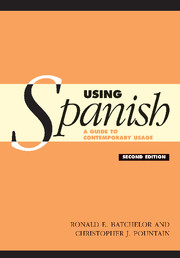Book contents
- Frontmatter
- Contents
- Authors' acknowledgements
- Preface to the second edition
- List of abbreviations and symbols
- Glossary
- The Spanish speaking world: countries where Spanish is spoken, with an estimate of the numbers of native speakers
- 1 Introduction
- 2 Passages illustrating register and local variety
- Part I Vocabulary
- 3 Misleading similarities between Spanish and English
- 4 Similarities between Spanish words
- 5 Fields of meaning – vocabulary extension
- 6 Complex verbal expressions
- 7 Affective suffixes
- 8 Idioms, similes and proverbs
- 9 Proper names
- 10 Adjectives pertaining to countries and towns
- 11 Abbreviations
- 12 Latin expressions
- 13 Anglicisms
- 14 Grammatical terms
- 15 Interjections
- 16 Fillers
- 17 Transition words
- 18 Numerals
- 19 Measurements
- 20 Semi-technical vocabulary
- Part II Grammar
- Index
7 - Affective suffixes
Published online by Cambridge University Press: 05 June 2012
- Frontmatter
- Contents
- Authors' acknowledgements
- Preface to the second edition
- List of abbreviations and symbols
- Glossary
- The Spanish speaking world: countries where Spanish is spoken, with an estimate of the numbers of native speakers
- 1 Introduction
- 2 Passages illustrating register and local variety
- Part I Vocabulary
- 3 Misleading similarities between Spanish and English
- 4 Similarities between Spanish words
- 5 Fields of meaning – vocabulary extension
- 6 Complex verbal expressions
- 7 Affective suffixes
- 8 Idioms, similes and proverbs
- 9 Proper names
- 10 Adjectives pertaining to countries and towns
- 11 Abbreviations
- 12 Latin expressions
- 13 Anglicisms
- 14 Grammatical terms
- 15 Interjections
- 16 Fillers
- 17 Transition words
- 18 Numerals
- 19 Measurements
- 20 Semi-technical vocabulary
- Part II Grammar
- Index
Summary
One of the characteristic richnesses of Spanish, especially in R1, is its use of suffixes which can express a wide range of affective notions (size, affection, disapproval, irony, etc). Some stems and suffixes are so firmly associated that they form words in their own right, eg bolita =berry, telón = (theatre) curtain, parrilla = grill, camarín (m) = dressing room, caballete (m) = easel, hoyuelo =dimple.
In Mexico, the -ito suffix is extremely frequent, and many very common nouns, such as agüita, casita, cochecito, pancita and solito regularly take the suffix without any implication regarding size.
Affective suffixes are used most often with nouns and adjectives, although the use of -ito/a extends to past participles used adjectivally and even to adverbs:
Está completamente dormidito
He's sound asleep
Hay que hablar bajito
You must speak really quietly
Lo haré en seguidita
I'll do it right away
†¡Ahorita! (used regularly in the sense of Pen ahora in Central America)
note: the attachment of some suffixes (the main ones are -ín, -ete, -ón and -azo) to noun stems may lead to a change in gender from feminine to masculine, eg novela (f), but novelón (m).
-ito/a (also -(e)cito/a)
This is one of the commonest suffixes, especially in Latin America.
- Type
- Chapter
- Information
- Using SpanishA Guide to Contemporary Usage, pp. 192 - 194Publisher: Cambridge University PressPrint publication year: 2005



